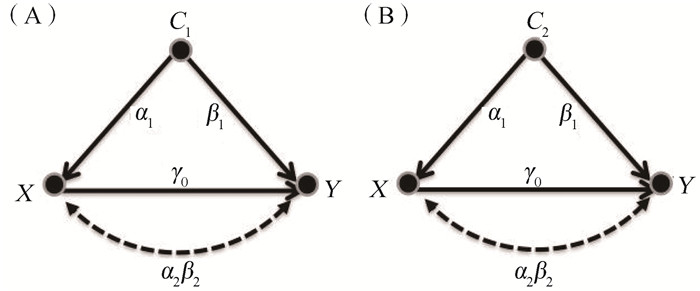| [1] |
Dahabreh IJ, Haneuse SJA, Robins JM, et al. Study Designs for Extending Causal Inferences From a Randomized Trial to a Target Population[J]. Am J Epidemiol, 2021, 190(8): 1632-1642. DOI: 10.1093/aje/kwaa270.
|
| [2] |
Ridder G, Moffitt R. The econometrics of data combination[J]. Handbook Econometrics, 2007, 6: 5469-5547. DOI: 10.1016/s1573-4412(07)06075-8.
|
| [3] |
Yang S, Kim JK. Statistical data integration in survey sampling: a review[J]. Jpn J Stat Data Sci, 2020, 3: 625-650. DOI: 10.1007/s42081-020-00093-w.
|
| [4] |
Angrist JD, Krueger AB. The effect of age at school entry on educational attainment: an application of instrumental variables with moments from two samples[J]. JASA, 1992, 87(418): 328-336. DOI: 10.2307/2290263.
|
| [5] |
Degtiar I, Rose S. A review of generalizability and transportability[J]. arXiv preprint arXiv: 2102.11904, 2021. DOI: 10.48550/arXiv.2102.11904.
|
| [6] |
Rubin, Donald B. Estimating causal effects of treatments in randomized and nonrandomized studies[J]. J Educ Psychol, 1974, 66(5): 688-701. DOI: 10.1037/h0037350.
|
| [7] |
Lesko CR, Buchanan AL, Westreich D, et al. Generalizing study results: a potential outcomes perspective[J]. Epidemiology, 2017, 28(4): 553-561. DOI: 10.1097/EDE.0000000000000664.
|
| [8] |
Stuart EA, Cole SR, Bradshaw CP, et al. The use of propensity scores to assess the generalizability of results from randomized trials[J]. J R Stat Soc Ser A Stat Soc, 2001, 174(2): 369-386. DOI: 10.1111/j.1467-985X.2010.00673.x.
|
| [9] |
Dahabreh IJ, Robertson SE, Steingrimsson JA, et al. Extending inferences from a randomized trial to a new target population[J]. Stat Med, 2020, 39(14): 1999-2014. DOI: 10.1002/sim.8426.
|
| [10] |
Cole SR, Stuart EA. Generalizing evidence from randomized clinical trials to target populations: The ACTG 320 trial[J]. Am J Epidemiol, 2010, 172(1): 107-115. DOI: 10.1093/aje/kwq084.
|
| [11] |
Colm O'Muircheartaigh, Larry V. Hedges. Generalizing from unrepresentative experiments: a stratified propensity score approach[J]. J R Stat Soc C-appl, 2014, 63(2): 195-210. DOI: 10.1111/rssc.12037.
|
| [12] |
Tipton E. Improving generalizations from experiments using propensity score subclassification: Assumptions, properties, and contexts[J]. JEBS, 2013, 38(3): 239-266. DOI: 10.3102/1076998612441947.
|
| [13] |
Hartman E, Grieve R, Ramsahai R, et al. From sample average treatment effect to population average treatment effect on the treated: combining experimental with observational studies to estimate population treatment effects[J]. J R Stat Soc A Stat, 2015, 178(3): 757-778. DOI: 10.1111/rssa.12094.
|
| [14] |
Rudolph KE, Laan MJ. Robust estimation of encouragement-design intervention effects transported across sites[J]. J R Stat Soc B, 2017, 79(5): 1509-1525. DOI: 10.1111/rssb.12213.
|
| [15] |
Daniel W, Edwards JK, Lesko CR, et al. Transportability of trial results using inverse odds of sampling weights[J]. Am J Epidemiol, 2017, 186(8): 1010-1014. DOI: 10.1093/aje/kwx164.
|
| [16] |
Ashley LB, Michael GH, Stephen RC, et al. Generalizing evidence from randomized trials using inverse probability of sampling weights[J]. J R Stat Soc A Stat, 2018, 181(4): 1193-1209. DOI: 10.1111/rssa.12357.
|
| [17] |
Dahabreh IJ, Hernán MA. Extending inferences from a randomized trial to a target population[J]. Eur J Epidemio, 2019, 34(8): 719-722. DOI: 10.1007/s10654-019-00533-2.
|
| [18] |
Toh S. Analytic and data sharing options in real-world multidatabase studies of comparative effectiveness and safety of medical products[J]. Clin Pharmacol Ther, 2020, 107(4): 834-842. DOI: 10.1002/cpt.1754.
|
| [19] |
Rosenbaum PR, Rubin DB. The central role of the propensity score in observational studies for causal effects[J]. Biometrika, 1983, 70(1): 41-55. DOI: 10.1093/biomet/70.1.41.
|
| [20] |
Ben BH. The prognostic analogue of the propensity score[J]. Biometrika, 2008, 95(2): 481-488. DOI: 10.1093/biomet/asn004.
|
| [21] |
Cook EF, Goldman L. Performance of tests of significance based on stratification by a multivariate confounder score or by a propensity score[J]. J Clin Epidemiol, 1989, 42(4): 317-324. DOI: 10.1016/0895-4356(89)90036-x.
|
| [22] |
Rassen JA, Solomon DH, Curtis JR, et al. Privacy-Maintaining propensity score-based pooling of multiple databases applied to a study of biologics[J]. Med Care, 2010, 48(6 Suppl): S83-S39. DOI: 10.1097/MLR.0b013e3181d59541.
|
| [23] |
Shu D, Yoshida K, Fireman BH, et al. Inverse probability weighted Cox model in multi-site studies without sharing individual-level data[J]. Stat Methods Med Res, 2020, 29(6): 1668-1681. DOI: 10.1177/0962280219869742.
|
| [24] |
Toh S, Gagne JJ, Rassen JA, et al. Confounding adjustment in comparative effectiveness research conducted within distributed research networks[J]. Med Care, 2013, 51: S4-10. DOI: 10.1097/MLR.0b013e31829b1bb1.
|
| [25] |
Yoshida K, Gruber S, Fireman BH, et al. Comparison of privacy-protecting analytic and data-sharing methods: a simulation study[J]. Pharmacoepidemiol Drug Saf, 2018, 27(9): 1034-1041. DOI: 10.1002/pds.4615.
|
| [26] |
Hou L, Yu Y, Sun X, et al. Causal mediation analysis with multiple causally non-ordered and ordered mediators based on summarized genetic data[J]. Stat Methods Med Res, 2022, 31(7): 1263-1279. DOI: 10.1177/09622802221084599.
|
| [27] |
Toh S, Wellman R, Coley RY, et al. Combining distributed regression and propensity scores: a doubly privacy-protecting analytic method for multicenter research[J]. Clin Epidemiol, 2018, 10: 1773-1786. DOI: 10.2147/CLEP.S178163.
|
| [28] |
Li H, Miao W, Cai Z, et al. Causal data fusion methods using summary-level statistics for a continuous outcome[J]. Stat Med, 2020, 39(8): 1054-1067. DOI: 10.1002/sim.8461.
|
| [29] |
Li H, Jia J, Yan R, et al. A causal data fusion method for the general exposure and outcome. Stat Med, 2022, 41(2): 328-339. DOI: 10.1002/sim.9239.
|
| [30] |
Hobbs BP, Carlin BP, Mandrekar SJ, et al. Hierarchical commensurate and power prior models for adaptive incorporation of historical information in clinical trials[J]. Biometrics, 2011, 67(3): 1047-1056. DOI: 10.1111/j.1541-0420.2011.01564.x.
|
| [31] |
Kaizer AM, Koopmeiners JS, Hobbs BP. Bayesian hierarchical modeling based on multisource exchangeability[J]. Biostatistics, 2018, 19(2): 169-184. DOI: 10.1093/biostatistics/kxx031.
|
| [32] |
Boatman JA, Vock DM, Koopmeiners JS. Borrowing from supplemental sources to estimate causal effects from a primary data source[J]. Stat Med, 2021, 40(24): 5115-5130. DOI: 10.1002/sim.9114.
|
| [33] |
Gelman A, King G, Liu C. Not asked and not answered: Multiple imputation for multiple surveys[J]. JASA, 1998, 93(443): 846-857. DOI: 10.1080/01621459.1998.10473737.
|
| [34] |
Jackson CH, Best NG, Richardson S. Bayesian graphical models for regression on multiple data sets with different variables[J]. Biostatistics, 2009, 10(2): 335-351. DOI: 10.1093/biostatistics/kxn041.
|
| [35] |
Murray JS, Reiter JP. Multiple imputation of missing categorical and continuous values via Bayesian mixture models with local dependence[J]. JASA, 2016, 111(516): 1466-1479. DOI: 10.1080/01621459.2016.1174132.
|
| [36] |
Antonelli J, Zigler C, Dominici F. Guided Bayesian imputation to adjust for confounding when combining heterogeneous data sources in comparative effectiveness research[J]. Biostatistics, 2017, 18(3): 553-568. DOI: 10.1093/biostatistics/kxx003.
|
| [37] |
Comment L, Coull BA, Zigler C, et al. Bayesian data fusion: Probabilistic sensitivity analysis for unmeasured confounding using informative priors based on secondary data[J]. Biometrics. 2022, 78(2): 730-741. DOI: 10.1111/biom.13436.
|
| [38] |
Cooper GF, Yoo C. Causal discovery from a mixture of experimental and observational data[J]. arXiv preprint arXiv: 1301.6686, 2013. DOI: 10.5555/2073796.2073810.
|
| [39] |
Tian J, Pearl J. Causal discovery from changes[J]. arXiv preprint arXiv: 1301. 2013, 2312. DOI: 10.5555/2074022.2074085.
|
| [40] |
Eaton D, Murphy K. Exact Bayesian structure learning from uncertain interventions[C] // Artificial intelligence and statistics. PMLR, 2007: 107-114.
|
| [41] |
Peters J, Bühlmann P, Meinshausen N. Causal inference by using invariant prediction: Identification and confidence intervals[J]. J R Stat Soc B, 2016, 78: 947-1012. DOI: 10.1111/rssb.12167.
|
| [42] |
Zhang K, Huang B, Zhang J, et al. Causal discovery from nonstationary/heterogeneous data: Skeleton estimation and orientation determination[J]. IJCAI (US). 2017: 1347-1353. DOI: 10.24963/ijcai.2017/187.
|
| [43] |
Mooij JM, Magliacane S, Claassen T. Joint causal inference from multiple contexts[J]. J Mach Learn Res, 2020, 21: 1-99, 108. DOI: 10.5555/3455716.3455815.
|
| [44] |
Claassen T, Heskes T. Causal discovery in multiple models from different experiments[J]. Advances in Neural Information Processing Systems, 2010, 23: 415-423.
|





 下载:
下载:




